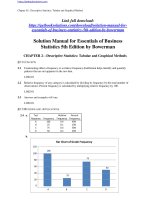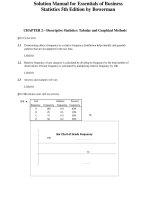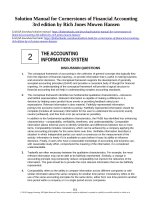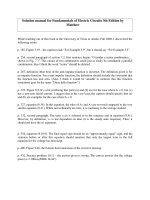Solution manual for principles of managerial finance 13th edition by gitman
Bạn đang xem bản rút gọn của tài liệu. Xem và tải ngay bản đầy đủ của tài liệu tại đây (639.2 KB, 14 trang )
buy this full document at
Part 1
Introduction to Managerial Finance
Chapters in this Part
Chapter 1
The Role of Managerial Finance
Chapter 2
The Financial Market Environment
Integrative Case 1: Merit Enterprise Corp.
buy this full document at http://testbank.us
1Gitman/ZutterãPrinciplesofManagerialFinance,ThirteenthEdition
Chapter1
TheRoleofManagerialFinance
InstructorsResources
Overview
Thischapterintroducesthestudenttothefieldoffinanceandexplorescareeropportunitiesinbothfinancial
servicesandmanagerialfinance.Thethreebasiclegalformsofbusinessorganization(soleproprietorship,
partnership,andcorporation)andtheirstrengthsandweaknessesaredescribed,aswellastherelationship
betweenmajorpartiesinacorporation.Themanagerialfinancefunctionisdefinedanddifferentiatedfrom
economicsandaccounting.Thechapterthensummarizesthethreekeyactivitiesofthefinancialmanager:
financialanalysisandplanning,investmentdecisions,andfinancingdecisions.Adiscussionofthefinancial
managersgoalsmaximizingshareholderwealthandpreservingstakeholderwealthandtheroleof
ethicsinmeetingthesegoalsispresented.Thechapterincludesdiscussionoftheagencyproblemthe
conflictthatexistsbetweenmanagersandownersinalargecorporation.
Thischapter,andallthatfollow,emphasizehowthechaptercontentplaysavitalroleinthestudents
professionalandpersonallife.Eachchapterincludesanearlydiscussionoftherelevanceofthetopicto
majorsinaccounting,informationsystems,management,marketing,andoperations.Throughouteach
chapteraredetailedexamplesofhowthechapterstopicrelatestothestudent'sfinanciallife.These
pedagogictoolsshouldmotivatestudentstoquicklygraspanunderstandingofthechaptercontentand
employitinboththeirprofessionalandpersonallives.
SuggestedAnswertoOpenerinReviewQuestion
IfZuckerbergisexpectedtoremaintheCEOofFacebookaftertheIPO,whywouldhebeworried
aboutgoingpublic?
Beyondthechallengesarisingfromtheinfluencesofoutsideinvestorsandgovernmentregulations,as
mentionedinthecase,thereisalsothefactthathisactionsandthefirmsfinancialstatementswouldbe
moreaccessibletothegeneralpublic.Whilethepublicmightrewardhimwithahighersalaryingood
years,thereisapotentialthathecouldberemovedfromofficeinbadyears.Also,Facebookwouldbea
tantalizingcompanytomanyotherfirms,makingitatakeovertarget.
AnswerstoReviewQuestions
1. Financeistheartandscienceofmanagingmoney.Financeaffectsallindividuals,businesses,and
governmentsintheprocessofthetransferofmoneythroughinstitutions,markets,andinstruments.
Atthepersonallevel,financeisconcernedwithanindividualsdecisionsregardingthespendingand
investingofincome.Businessesalsohavetodeterminehowtospendandinvestrevenues.
â2012PearsonEducation,Inc.PublishingasPrenticeHall
buy this full document at
2. Financial services is the area of finance concerned with the design and delivery of advice and
financial products to individuals, businesses, and government.
© 2012 Pearson Education, Inc. Publishing as Prentice Hall
3Gitman/ZutterãPrinciplesofManagerialFinance,ThirteenthEdition
Managerialfinanceencompassesthefunctionsofbudgeting,financialforecasting,creditadministration,
investmentanalysis,andfundsprocurementforthefirm.Managerialfinanceisthemanagementof
thefirmsfundswithinthefirm.Thisfieldoffersmanycareeropportunities,includingfinancial
analyst,capitalbudgetinganalyst,andcashmanager.(Note:Otheranswerspossible.)
3. Soleproprietorshipsarethemostcommonformofbusinessorganization,whilecorporationsare
responsibleforthemajorityofbusinessreceiptsandprofits.Corporationsaccountforthemajorityof
businessreceiptsandprofitsbecausetheyreceivecertaintaxadvantagesandcanexpandmoreeasily
duetoaccesstocapitalmarkets.
4. Stockholdersarethetrueowners,throughequityincommonandpreferredstock,ofacorporation.
Theyelecttheboardofdirectors,whichhastheultimateauthoritytoguidecorporateaffairsandset
generalpolicy.Theboardisusuallycomposedofkeycorporatepersonnelandoutsidedirectors.The
presidentorchiefexecutiveofficer(CEO)reportstotheboard.Heorsheisresponsiblefordayưtoưday
operationsandcarryingoutpoliciesestablishedbytheboard.Theownersofthecorporationdonot
haveadirectrelationshipwithmanagementbutgivetheirinputthroughtheelectionofboardmembers
andvotingonmajorcharterissues.Theownersofthefirmarecompensatedthroughthereceiptof
cashdividendspaidbythefirmorbyrealizingcapitalgainsthroughincreasesinthepriceoftheir
commonstockshares.
5. Themostpopularformoflimitedliabilityorganizationsotherthancorporationsare:
LimitedpartnershipsApartnershipwithatleastonegeneralpartnerwithunlimitedliabilityand
oneormorelimitedpartnerswhohavelimitedliability.Inreturnforthelimitedliability,thelimited
partnersareprohibitedfromactivemanagementofthepartnership.
ScorporationIfcertainrequirementsaremet,theScorporationcanbetaxedasapartnership
butreceivemostofthebenefitsofthecorporateformoforganization.
Limitedliabilitycorporation(LLC)ThisformoforganizationislikeanScorporationinthatit
istaxedasapartnershipbutprimarilyfunctionslikeacorporation.TheLLCdiffersfromthe
Scorporationinthatitisallowedtoownothercorporationsandbeownedbyothercorporations,
partnerships,andnonưU.S.residents.
Limitedliabilitypartnership(LLP)Apartnershipformauthorizedbymanystatesthatgivesthe
partnerslimitedliabilityfromtheactsofotherpartners,butnotfrompersonalindividualactsof
malpractice.TheLLPistaxedasapartnership.Thisformismostfrequentlyusedbylegaland
accountingprofessionals.
Thesefirmsgenerallydonothavelargenumbersofowners.Mosttypicallytheyhavefewerthan
100owners.
6. Virtuallyeveryfunctionwithinafirmisinsomewayconnectedwiththereceiptordisbursement
ofcash.Thecashrelationshipmaybeassociatedwiththegenerationofsalesthroughthemarketing
department,theincurringofrawmaterialcoststhroughpurchasing,ortheearningsofproduction
workers.Sincefinancedealsprimarilywithmanagementofcashforoperationofthefirm,every
personwithinthefirmneedstobeknowledgeableoffinancetoeffectivelyworkwithemployees
ofthefinancialdepartments.
Individualsplan,monitor,andassessthefinancialaspectsoftheiractivitiesoveragivenperiod
throughtheconsiderationofcashinflowsandoutflows.
7. Thegoalofthefirm,andthereforeallmanagers,istomaximizeshareholderwealth.Thisgoalis
measuredbyshareprice;anincreasingpricepershareofcommonstockrelativetothestockmarket
asawholeindicatesachievementofthisgoal.
â2012PearsonEducation,Inc.PublishingasPrenticeHall
Chapter 1 The Role of Managerial Finance 4
8. Profit maximization is not consistent with wealth maximization due to: (1) the timing of earnings per
share, (2) earnings that do not represent cash flows available to stockholders, and (3) a failure to
consider risk.
9. Risk is the chance that actual outcomes may differ from expected outcomes. Financial managers must
consider both risk and return because of their inverse effect on the share price of the firm. Increased
risk may decrease the share price, while increased return is likely to increase the share price.
10. In recent years the magnitude and severity of “white collar crime” has increased dramatically, with
a corresponding emphasis on prosecution by government authorities. As a result, the actions of all
corporations and their executives have been subjected to closer scrutiny. This increased scrutiny of
this type of crime has resulted in many firms establishing corporate ethics guidelines and policies
to cover employee actions in dealing with all corporate constituents. The adoption of high ethical
standards by a corporation strengthens its competitive position by reducing the potential for litigation,
maintaining a positive image, and building shareholder confidence. The result is enhancement of
longterm value and a positive effect on share price.
11. The treasurer or financial manager within the mature firm must make decisions with respect to
handling financial planning, acquisition of fixed assets, obtaining funds to finance fixed assets,
managing working capital needs, managing the pension fund, managing foreign exchange, and
distribution of corporate earnings to owners.
12. Finance is often considered a form of applied economics. Firms operate within the economy and must
be aware of economic principles, changes in economic activity, and economic policy. Principles
developed in economic theory are applied to specific areas in finance. From macroeconomics comes
the institutional structure in which money and credit flows take place. From microeconomics, finance
draws the primary principle used in financial management, marginal analysis. Since this analysis of
marginal benefits and costs is a critical component of most financial decisions, the financial manager
needs basic economic knowledge.
13. Accountants operate on an accrual basis, recognizing revenues at the point of sale and expenses when
incurred. The financial manager focuses on the actual inflows and outflows of cash, recognizing
revenues when actually received and expenses when actually paid.
The accountant primarily gathers and presents financial data; the financial manager devotes attention
primarily to decision making through analysis of financial data.
14. The two key activities of the financial manager as related to the firm’s balance sheet are:
a. Making investment decisions: Determining both the most efficient level and the best mix of
assets; and
b. Making financing decisions: Establishing and maintaining the proper mix of short and longterm
financing and raising needed financing in the most economical fashion.
Investment decisions concern the lefthand side of the balance sheet (current and fixed assets).
Financing decisions deal with the righthand side of the balance sheet (current liabilities, longterm
debt, and stockholders’ equity).
© 2012 Pearson Education, Inc. Publishing as Prentice Hall
5Gitman/ZutterãPrinciplesofManagerialFinance,ThirteenthEdition
15. Corporategovernancereferstoasystemoforganizationalcontrolthatisusedtodefineandestablish
linesofresponsibilityandaccountabilityamongmajorparticipantsinthecorporation.Theseparticipants
includetheshareholders,boardofdirectors,officers,andmanagersofthecorporationsandother
stakeholders.Acompanysorganizationalchartisanexampleofabroadarrangementofcorporate
governance.Moredetailedresponsibilitieswouldbeestablishedwithineachbranchofthe
organizationalchart.
TheSarbanesưOxleyActof2002isdirectedtowardreducingtheapparentconflictsofinterestthat
existinmanycorporatestructures.Theacthasmanyprovisions,butthemajorthrustoftheactisto
reducethenumberofsituationsinwhichaconflictofinterestcanariseandtoholdmanagementmore
accountableforthefinancialandoperatinginformationtheycommunicatedtothepublic.
16. Firmsincuragencycoststopreventorminimizeagencyproblems.Itisunclearwhethertheyare
effectiveinpractice.Thefourcategoriesofagencycostaremonitoringexpendituresincurredby
theownersforauditandcontrolprocedures,bondingexpenditurestoprotectagainstthepotential
consequencesofdishonestactsbymanagers,structuringexpendituresthatusemanagerialcompensation
planstoprovidefinancialincentivesformanagerialactionsconsistentwithsharepricemaximization,
andopportunitycostsresultingfromthedifficultiestypicallyencounteredbylargeorganizationsin
respondingtonewopportunities.
Theagencyproblemandtheassociatedagencycostscanbereducedbyaproperlyconstructedand
followedcorporategovernancestructure.Thestructureofthegovernancesystemshouldbedesigned
toinstituteasystemofchecksandbalancestoreducetheabilityandincentivesofmanagementto
deviatefromthegoalofshareholderwealthmaximization.
17. Structuringexpendituresarecurrentlythemostpopularwaytodealwiththeagencyproblemand
alsothemostpowerfulandexpensive.Compensationplanscanbeeitherincentiveorperformance
plans.Incentiveplanstiemanagementperformancetoshareprice.Managersmayreceivestock
optionsgivingthemtherighttopurchasestockatasetprice.Thisprovidestheincentivetotake
actionsthatmaximizestockpricesothatthepricewillriseabovetheoptionspricelevel.Thisform
ofcompensationplanhasfallenfromfavorrecentlybecausemarketbehavior,whichhasasignificant
effectonshareprice,isnotundermanagementscontrol.Asaresult,performanceplansaremore
populartoday.Withthese,compensationisbasedonperformancemeasures,suchasearningsper
share(EPS),EPSgrowth,orotherreturnratios.Managersmayreceiveperformancesharesand/or
cashbonuseswhenstatedperformancegoalsarereached.
Inpractice,recentstudieshavebeenunabletodocumentanysignificantcorrelationbetweenCEO
compensationandshareprice.
18. Marketforcesforexample,shareholderactivismfromlargeinstitutionalinvestorscanreduceor
avoidtheagencyproblembecausethesegroupscanusetheirvotingpowertoelectnewdirectorswho
supporttheirobjectivesandwillacttoreplacepoorlyperformingmanagers.Inthisway,thesegroups
placepressureonmanagementtotakeactionsthatmaximizeshareholderwealth.
Thethreatofhostiletakeoversalsoactsasadeterrenttotheagencyproblem.Hostiletakeovers
occurwhenacompanyorgroupnotsupportedbyexistingmanagementattemptstoacquirethe
firm.Becausetheacquirerlooksforcompaniesthatarepoorlymanagedandundervalued,this
threatmotivatesmanagerstoactinthebestinterestsofthefirmsowners.
Institutionalinvestorsareapowerfulsourceofshareholderinvolvementinthemonitoringof
managerstoreducetheagencyproblem.Institutionsholdlargequantitiesofsharesinmanyofthe
corporationsintheirportfolio.Managersoftheseinstitutionsshouldbeactiveinthemonitoringof
â2012PearsonEducation,Inc.PublishingasPrenticeHall
Chapter 1 The Role of Managerial Finance 6
management and vote their shares for the benefit of the shareholders. The power of institutional
investors far exceeds the voting power of individual investors.
© 2012 Pearson Education, Inc. Publishing as Prentice Hall
7Gitman/ZutterãPrinciplesofManagerialFinance,ThirteenthEdition
SuggestedAnswertoFocusonPracticeBox:Professional
CertificationsinFinance
Whydoemployersvaluehavingemployeeswithprofessionalcertifications?
Studyingtopasscertificationexamsallowsemployeestocontinuetheireducationbeyondtheir
undergraduatedegree.Thestudywillbefocusedononeareaoffinance,whichislikelytobethatneeded
toperformtheirjobwell.Furthermore,itwillallowtheemployertoadvertisetheadditionaltrainingof
theemployees,andtherebyattractadditionalbusiness.
SuggestedAnswertoFocusonEthicsBox:WillGoogleLiveUp
toItsMotto?
Isthegoalofmaximizationofshareholderwealthnecessarilyethicalorunethical?
Itisnotthegoalthatmakesmaximizationofshareholderwealthethicalorunethical,itisactionsofthe
financialmanagerinpursuitofthisgoal.
HowcanGooglejustifyitsactionsintheshortruntoitslongưruninvestors?
Googlemuststressthelongưrunbenefitsofitsdecisiontoinvestors.Forexample,Googlemightmakethe
casethatthecompanysstanceinChinawillopenupbusinessopportunitieselsewhere.Theymightalso
showthatthecompanysbusinessmodelismorevaluablewhensearchresultsareuncensored.
AnswerstoWarmưUpExercises
E1ư1.
Comparisonofadvantagesanddisadvantagesofapartnershipversusincorporation.
Answer: WhileJackandAnndisagreeoverwhetherornottheirfirmshouldincorporateorremainasa
partnership,eachformofbusinessorganizationhasitsadvantagesanddisadvantages.One
advantageofapartnershipisthatincomeistaxedateachpartnersindividualtaxratethat
includes10%,15%,25%,andhigherratesuptoatoprateof35%whilecorporateratesare
15%,25%,and34%withatoprateof39%.Thecorporationisallowedtoretainaccumulated
taxableincome,butforapersonalservicecorporationsuchasJackandAnnstaxpreparation
service,thereisanadditionaltax,calledanaccumulatedearningstax,of15%foraccumulated
taxableincomeinexcessof$150,000.Ifcorporateearningsarepaidoutassalary,Jackand
Annwillpaytheirindividualratesastheydoontheirpartnershipearnings.Ifsomeofthe
incomeispaidoutintheformofdividendsitwillbetaxedtwice,firstascorporateincomeand
thenasdividendincome(generally5%or15%dependingupontheindividualstaxbracket).
Whiletaxationofincomeisakeyfactorindecidingwhichformofbusinessorganizationto
select,twootherfactorsarealsoimportant.Inapartnership,eachpartnerhasunlimited
liabilityandmayhavetocoverdebtsofotherpartners,whilecorporateownershavelimited
liabilitythatguaranteesthattheycannotlosemorethantheyhaveinvestedinthecorporation.
Thethirdmajorconsiderationiseaseoftransferofthebusiness.Partnershipsareharderto
transferandaretechnicallydissolvedwhenapartnerdies,whileacorporationcanhaveavery
longlifewithownershipreadilytransferredthroughthesaleofstock.
â2012PearsonEducation,Inc.PublishingasPrenticeHall
Chapter 1 The Role of Managerial Finance 8
If a third party was asked to decide which legal form of business A&J Tax Preparation should
take, it would be useful to have the following information:
E12.
Marital status and tax situation of each partner
Expectation of the longevity of the firm
Age of the current owners
Current plan of succession
Risk tolerance of the owners
Expectation of future tax law changes
Capital needs of the firm
Growth prospects of the firm
Reasons for each partner’s view of the preferred form of ownership
Cash flow vs. accrued profits
Answer: It is not unusual for a firm to be profitable yet experience a cash crunch. The most common cause
is when expenses have a shorter due date than expected revenue. In such cases the firm must
arrange shortterm financing to meet its debt obligations before the revenue arrives. If the
forthcoming cash crunch is not a new situation for this firm, management should probably
consider going ahead with the yearend party if it is important to employee morale and the
future success of the firm, as long as adequate shortterm funding can be arranged. On the other
hand, if the firm has not experienced such a cash crunch before, there may be larger problems
looming ahead and it would be unseemly to spend cash on a party that would be better spent
meeting the debt obligations of the firm.
E13.
Sunk costs
Answer: Marginal costbenefit analysis ignores sunk costs, so the $2.5 million dollars is irrelevant to
the current decision that must be made. At this point there are two questions that must be answered.
First, will the $10,000 additional investment generate a PV of expected revenue that will exceed
the $10,000 investment? In other words, will the project generate a positive net PV? If it does,
the project must be considered further to see if it is the best use of capital. If the firm has a need
to ration capital, the project must then be compared to other projects competing for the limited
capital to see if it is viable. The fact that the project’s technology has been surpassed by new
technology does not immediately disqualify the project since new technology does not ensure
a positive costbenefit result. In this case, a small $10,000 investment might avoid a heavy
expenditure in new technology. Depending upon the industry, however, failure to keep up with
competitors can be devastating. The key may well lie in the description “the project has little
chance to be viable,” which indicates that approving the $10,000 is likely to be throwing good
money after bad.
E14.
Agency costs
Answer: Agency costs are the costs borne by stockholders to maintain a governance structure that
ensures against dishonest acts of management, and gives managers the financial incentive to
maximize share price. One example of agency costs is stock options, which are used to provide
an incentive for managers to work diligently for the benefit of the firm. Tips are similar to
stock options in that they are offered as rewards for good service much as stock options are
used to reward managers, presumably based on their good performance—which subsequently
leads to a higher stock price. The Donut Shop, Inc. example does not represent a clear case of
agency costs because it is the management itself that has instituted the “No tips” policy and the
employees have responded with reduced performance. By banning tips, the management has
created a situation where an agency cost may be necessary to provide an incentive for employees
to resume their former level of performance.
© 2012 Pearson Education, Inc. Publishing as Prentice Hall
9Gitman/ZutterãPrinciplesofManagerialFinance,ThirteenthEdition
OnesolutionthatmayworkforDonutShop,Inc.istoinstituteaprofitưsharingplanthatreaches
downtotheemployeelevelwheretheslowdownandinefficiencyareoccurring.Aprofitưsharing
planisdesignedtomotivatetheemployeesandcouldalleviatetheaggravationcausedbythe
noưtippolicy,butmustbeclearlyidentifiedasthereplacementtotippinginordertobeeffective.
Aprofitưsharingplanisusuallyviewedbytheemployeesasarewardforgoodperformance,but
doesnothavetheimmediacyofthepositiveeffectthatanemployeegetsfromatip.
Itisunclearfromthecasewhetherthenewnoưtippolicyisacompanyưwidepolicyorsimply
theactionsofafewbranchmanagers.However,therealsolutionhereistorecognizethatthe
noưtippolicyhascreatedanunnecessarybacklashthatcanbealleviatedbyreversingmanagements
positionwithoutincurringtheadditionalcostsofrevisingthecurrentemployeebenefitplan
andpayingoutaportionofcorporateprofits.
SolutionstoProblems
P1ư1.
Liabilitycomparisons
LG2;Basic
a. Ms.Harperhasunlimitedliability.
b. Ms.Harperhasunlimitedliability.
c. Ms.Harperhaslimitedliability,whichguaranteesthatshecannotlosemorethansheinvested.
P1ư2.
Accrualincomevs.cashflowforaperiod
LG4;Basic
a.
Sales
Costofgoodssold
Netprofit
$760,000
300,000
$460,000
b. Cashreceipts
Costofgoodssold
Netcashflow
$690,000
300,000
$390,000
c.
P1ư3.
Thecashflowstatementismoreusefultothefinancialmanager.Theaccountingnetincome
includesamountsthatwillnotbecollectedand,asaresult,donotcontributetothewealthof
theowners.
Cashflowstatement
LG4;Intermediate
a.
Totalcashinflow:$450$4,500$4,950
Totalcashoutflow:$1,000$500$800$355$280$1,200$222$4,357
b. Netcashflow:$4,950$4,357$593
c.
IfJaneisfacingashortage,shecouldcutbackonsomeofherdiscretionaryitems,including
clothing,diningout,andgas(i.e.,travelless).
d. IfJanehasasurplusinAugust,sheshouldcomparethesecashflowstothoseofothermonths
andverifythatAugustscashflowsaretypical.Shemay,forinstance,observetheexistence
oflargeautomobileinsurancebillsortendencytospendmoreduringtheChristmasholiday
season.Ifshehassuchneeds,Janewillwanttosavethe$593inamoneymarketsecurity,
â2012PearsonEducation,Inc.PublishingasPrenticeHall
Chapter 1 The Role of Managerial Finance 10
where she is unlikely to face a decline in investment. If her August net cash flow is not needed
to pay anticipated bills, she should invest in a diversified portfolio.
P14.
Marginal costbenefit analysis and the goal of the firm
PG 3, 5; Challenge
a. Marginal benefits of new robotics Marginal benefits of original robotics Marginal benefits
of proposed robotics
$560,000 $400,000 $160,000
b. Marginal cost of new robotics – Sales price of current robotics = Marginal cost of proposed
robotics
$220,000 $70,000 $150,000
c. Net benefits of new robotics Marginal benefits of proposed robotics Marginal cost of
proposed robotics
$160,000 $150,000
d. Ken Allen should recommend the new robotics be used on the heavy truck gear line.
The marginal benefits exceed the marginal costs
e. Ken Allen should determine whether there will be additional training necessary with the new
robotics, whether even better robotics may be available in a short while, and what will be the
energy consumption of the new robotics.
P15.
Identifying agency problems, costs, and resolutions
LG 4; Intermediate
a. In this case the employee is being compensated for unproductive time. The company must
pay someone to take her place during her absence. Installation of a time clock that must be
punched by the receptionist every time she leaves work and returns would result in either:
(1) her returning on time or (2) reducing the cost to the firm by reducing her pay for the
lost work.
b. The costs to the firm are in the form of opportunity costs. Money budgeted to cover the
inflated costs of this project proposal is not available to fund other projects that may help
to increase shareholder wealth. Make the management reward system based on how close the
manager’s estimates come to the actual cost rather than having them come in below cost.
c. The manager may negotiate a deal with the merging competitor that is extremely beneficial to
the executive and then sell the firm for less than its fair market value. A good way to reduce
the loss of shareholder wealth would be to open the firm up for purchase bids from other
firms once the manager makes it known that the firm is willing to merge. If the price offered
by the competitor is too low, other firms will raise the price closer to its fair market value.
d. Generally parttime or temporary workers are not as productive as fulltime employees. These
workers have not been on the job as long to increase their work efficiency. Also, the better
employees generally need to be highly compensated for their skills. This manager is getting
rid of the highestcost employees to increase profits. One approach to reducing the problem
would be to give the manager performance shares if he or she meets certain stated goals.
Implementing a stock incentive plan tying management compensation to share price would
also encourage the manager to retain quality employees.
© 2012 Pearson Education, Inc. Publishing as Prentice Hall
11Gitman/ZutterãPrinciplesofManagerialFinance,ThirteenthEdition
P1ư6.
EthicsProblem
LG3;Intermediate
Thephraseethicalconstraintsisquitebroad.Thecompanymaybereferringtolegalissues,and
thefactthatitwillcomplywithlaws.Forinstance,itmaybeimplyingthatitwillnotbeusingillegal
immigrantsandpayingthemareducedsalary.Itmayrefertotheuseofsubstandardmaterials,which
arelesslikelytoholdupoveranextendedperiodoftime.Sometimestheuseofsubstandard
manufacturingfacilitieswillincreasethechanceofharmtoemployeesorworse,aswitnessedby
theBPGulfoilspillinApril2010.
Case
Casestudiesareavailableonwww.myfinancelab.com.
AssessingtheGoalofSportsProducts,Inc.
a. Maximizationofshareholderwealth,whichmeansmaximizationofshareprice,shouldbetheprimary
goalofthefirm.Unlikeprofitmaximization,thisgoalconsiderstiming,cashflows,andrisk.Italso
reflectstheworthoftheownersinvestmentinthefirmatanytime.Itisthevaluetheycanrealize
shouldtheydecidetoselltheirshares.
b. Yes,thereappearstobeanagencyproblem.Althoughcompensationformanagementistiedtoprofits,
itisnotdirectlylinkedtoshareprice.Inaddition,managementsactionswithregardtopollution
controlssuggestaprofitmaximizationfocus,whichwouldmaximizetheirearnings,ratherthanan
attempttomaximizeshareprice.
c. Thefirmsapproachtopollutioncontrolseemstobequestionableethically.Whileitisunclearwhether
theiractswereintentionaloraccidental,itisclearthattheyareviolatingthelawanillegalactpotentially
leadingtolitigationcostsandasaresultaredamagingtheenvironment,animmoralandunfairact
thathaspotentialnegativeconsequencesforsocietyingeneral.Clearly,SportsProductshasnotonly
brokenthelawbutalsoestablishedpoorstandardsofconductandmoraljudgment.
d. Fromtheinformationgiventhereappearstobeaweakcorporategovernancesystem.Thefact
thatmanagementisabletomeasureandrewardtheirperformanceonprofitsindicatesthatnoone
iswatchingoutfortheshareholders.LorenandDalesconcernsindicatethatemployeesapparently
haveaninterestinthelongưrunsuccessofthefirm.Allowingthecontinuationofpollutionviolations
isalsoapparentlyescapingtheinterestandcontrolabilityofotherswhoshouldbemonitoringthefirm.
e. Somespecificrecommendationsforthefirminclude:
Tiemanagement,andpossiblyemployee,compensationtosharepriceoraperformanceưbased
measureandmakesurethatallinvolvedownstockandhaveastakeinthefirm.Beingcompensated
partiallyonthebasisofsharepriceoranotherperformancemeasure,andowningstockinthefirm
willmorecloselylinkthewealthofmanagersandemployeestothefirmsperformance.
Complywithallfederalandstatelawsaswellasacceptedstandardsofconductormoraljudgment.
Establishacorporateethicspolicy,tobereadandsignedbyallemployees.
Setupacorporategovernancesystemthathasasitsbasistheoversightandwelfareofallthe
stakeholdersinthefirm.
(Otheranswersare,ofcourse,possible.)
â2012PearsonEducation,Inc.PublishingasPrenticeHall
Chapter 1 The Role of Managerial Finance 12
Spreadsheet Exercise
The answer to Chapter 1’s Monsanto spreadsheet problem is located on the Instructor’s Resource Center
at www.pearsonhighered.com/irc under the Instructor’s Manual.
Group Exercise
Group exercises are available on www.myfinancelab.com.
Notes for Adopters
The motivation for these group exercises is to place the learning goals of each chapter within the context
of a fictitious firm while giving students a valuable set of teamwork skills. Creativity is encouraged, while
the strong links of each assignment to a realworld, shadow firm should ground each group’s work in
reality. Any of these assignments and their deliverables can be modified to better fit within an adopter’s
course goals as they were designed with an eye toward flexibility of use. The learning through these
exercises should be something students enjoy, being both applicable to the real world and less confining
than traditional homework.
The first issue for adopters to address is group composition and size. Should students selfseparate or
be divided by their instructor? How big should the groups be? This is a semesterlong assignment and
students will need to get along with their fellow group members. If students choose their own groups it
may, though not always, reduce the incidence of intragroup squabbles. Diversity within the groups might
then be sacrificed, however. One strategy is to ask students to first pairoff. The instructor can then join
the pairs into groups of 4. This pairing of the pairs could be done randomly through a numberinthehat
selection process, as could the entire group setup.
Group size does matter and these exercises were designed for a workload spread across a minimum of
3 students. Larger groups would lessen the homework load; however, the issue of freeriding is often more
prevalent in larger groups, where slackers can hide. Management of larger groups is also more challenging
for the participants. The suggested group size is between 3–5 students.
Group leadership is another issue. The best situation might be rotating the CEO/leader, where each group
member has several opportunities to be in charge. Lastly, these exercises were designed to allow students
freedom but with the responsibility of working somewhat independently of their instructor. In this vein the
instructions for each assignment have been written to be relatively selfexplanatory.
Chapter 1
© 2012 Pearson Education, Inc. Publishing as Prentice Hall
13Gitman/ZutterãPrinciplesofManagerialFinance,ThirteenthEdition
Thisfirstchapterasksstudentstonametheirfictitiousfirmanddescribeitsbusiness.Asthisfirmisgoing
publicstudentsareaskedtoexplainwhyitisappropriateforthemtogopublic,andalsodiscussdifferent
managerialroleswithinthecorporation.Thegroupmustchooseashadowfirmtofollowthatispublicly
held,allowingthemtogatherasubstantialamountofinformationaboutitontheInternet.Thispubliclyư
tradedfirmshouldbeinanindustryrelatedtotheirfictitiousfirm.
Themostimportantcounselstudentscouldgetattheoutsetistospendtimemakingtheseinitialdecisions.
Laterworkisgoingtobuildonthesechoicesandcarefulchoosingisparamount.Forexample,inchoosing
theshadowfirm,studentsshouldpickawellưestablishedfirmwhoseinformation,includingfinancials,will
beeasilyfound.Thisalsoimpactstheirdecisionsregardingtheirownfictitiousfirm.Throughoutmanyof
thesubsequentchaptersstudentswillbetakingrealưworldinformationfromtheirshadowfirmandapplying
ittotheirfictitiousfirm;dressingtheirownfirmwiththeclothesoftheshadowfirm.Studentsshouldfeel
comfortableintheseclothes,soencouragingthemtochooseindustriestheyrefamiliarwith,orinterested
in,ishelpful.
â2012PearsonEducation,Inc.PublishingasPrenticeHall









